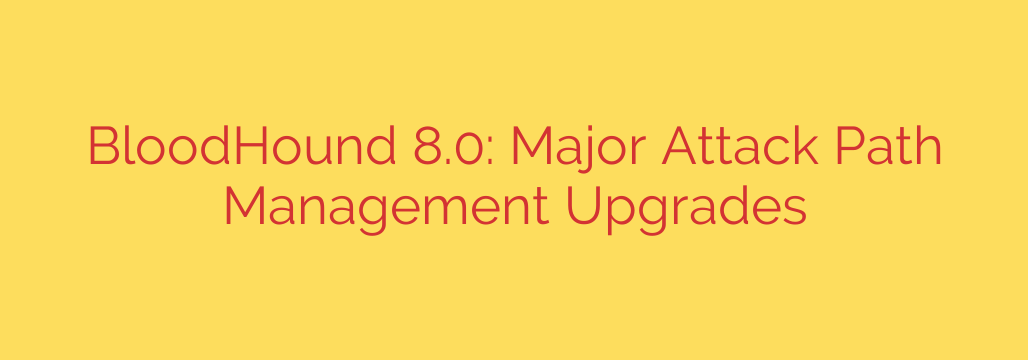
BloodHound 8.0: A Game-Changer for Active Directory Attack Path Management
For years, security professionals have relied on BloodHound to map out the complex web of permissions and relationships within Active Directory (AD) and Entra ID environments. It has been an indispensable tool for visualizing how an attacker could move from a low-privilege account to a domain administrator. However, visualizing the problem is only half the battle. The latest release, BloodHound 8.0, marks a monumental shift from simply identifying attack paths to actively managing them.
This upgrade isn’t just an incremental update; it’s a fundamental evolution in how we approach identity and infrastructure security. Let’s dive into the key enhancements and what they mean for your organization’s defense strategy.
The Core Evolution: From Pathfinding to Attack Path Management (APM)
The biggest challenge with older versions of BloodHound wasn’t a lack of data—it was an overabundance of it. Security teams were often presented with thousands, or even millions, of potential attack paths. This information overload could lead to analysis paralysis, making it difficult to know where to start or which vulnerabilities posed the most immediate threat.
BloodHound 8.0 directly addresses this by introducing a comprehensive Attack Path Management (APM) framework. This new approach is built on three pillars:
- Prioritization: Identifying which attack paths present the greatest risk.
- Remediation: Providing clear, actionable guidance to close these security gaps.
- Continuous Monitoring: Constantly reassessing the environment to ensure new vulnerabilities are caught and fixed.
This paradigm shift moves the tool from a diagnostic utility to a strategic security platform, enabling teams to proactively improve their security posture rather than just reactively analyzing it.
Key Upgrades in BloodHound 8.0
The new APM capabilities are powered by a series of significant technical and user-facing improvements. Here are the most impactful changes.
Intelligent Prioritization and Critical Choke Point Analysis
Not all attack paths are created equal. BloodHound 8.0’s most powerful new feature is its ability to analyze the entire graph of relationships and identify critical choke points. These are specific users, computers, or permissions that are part of a large number of high-impact attack paths.
By focusing remediation efforts on these choke points, security teams can eliminate thousands of potential attack paths with a single, targeted fix. This is a massive efficiency gain, allowing teams to achieve the greatest security impact with the least amount of effort. Instead of chasing down countless individual issues, you can now sever the critical links that attackers rely on most.
Actionable, Guided Remediation
Simply knowing a vulnerability exists is not enough. The new release provides step-by-step remediation guidance for discovered issues. When BloodHound identifies a dangerous permission or relationship, it now offers clear instructions on how to resolve it safely and effectively.
This feature is a game-changer for bridging the gap between security analysts and IT administrators. Instead of just sending a ticket that says “User X has a dangerous privilege,” security teams can now provide a detailed plan, including the exact commands or configuration changes needed to fix the problem. This reduces friction, speeds up resolution times, and minimizes the risk of misconfiguration.
Blazing-Fast Pathfinding and Analysis
Under the hood, BloodHound 8.0 features a completely re-engineered pathfinding algorithm. This new engine is significantly faster and more efficient, capable of processing massive datasets from large and complex enterprise environments in a fraction of the time it took previously.
This performance boost means security teams can get faster insights, run more frequent analyses, and keep up with the dynamic nature of modern identity systems without being bogged down by long processing times.
Continuous Security Posture Monitoring
Cybersecurity isn’t a one-time project; it’s an ongoing process. BloodHound 8.0 is designed for continuous monitoring. By regularly collecting data with the improved SharpHound collectors, organizations can track their security posture over time. This allows you to measure the effectiveness of your remediation efforts and demonstrate tangible security improvements to leadership. It also ensures that as your AD or Entra ID environment changes, new high-risk paths are identified and flagged for immediate attention.
Actionable Security Tips for Your Team
With these powerful new features, how can your security team leverage BloodHound 8.0 most effectively?
- Focus on Choke Points First: Run a full analysis and immediately target the top choke points identified by the platform. This is your highest-leverage activity.
- Integrate Remediation into Your Workflow: Use the detailed remediation guidance to create standardized procedures for your IT operations team. This ensures consistency and reduces human error.
- Establish a Baseline and Track Progress: Use the continuous monitoring capabilities to establish a baseline security score. Set goals for improvement and use the platform’s data to report on your progress every quarter.
- Educate Your Team on Identity Security: Use the visual maps and clear attack path chains to educate both your security team and system administrators on how seemingly minor permissions can lead to a full-scale compromise.
In conclusion, BloodHound 8.0 is far more than a simple update. It represents a mature and sophisticated approach to identity security, empowering organizations to move beyond reactive analysis and adopt a proactive, strategic Attack Path Management program. By helping teams prioritize, remediate, and continuously monitor their most critical security risks, it has solidified its place as an essential tool in any modern defensive arsenal.
Source: https://www.helpnetsecurity.com/2025/08/05/bloodhound-8-0-open-source-attack-path-management-platform/








